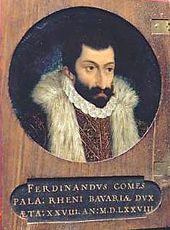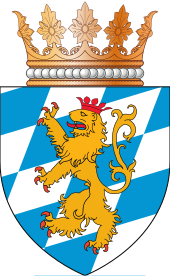Wartenberg (Bavarian noble family)

The Counts of Wartenberg were a Bavarian noble family that descended from the Wittelsbach rulers . This Ferdinandine line of the Wittelsbach family, which goes back to Duke Ferdinand of Bavaria , should not be confused with the numerous other families of this name .
history

Ferdinand of Bavaria (1550–1608) was a son of Duke Albrecht V of Bavaria (1528–1579) from his marriage to Archduchess Anna of Austria (1528–1590), the second daughter of Emperor Ferdinand I on December 26, 1588 married Ferdinand of Bavaria, against the opposition of his family, in morganatic marriage , Maria of Pettenbeck , the 15-year-old daughter of the Hague country judge George of Pettenbeck. Because of the low nobility of his wife, who was not recognized as equal under the house laws, Ferdinand renounced the succession to the Bavarian throne for himself and his descendants, but received extensive property in Wartenberg and Haag as well as the assurance of special privileges for any descendants (see below).
Duke Ferdinand and his family lived in a palace on the Rindermarkt in Munich. In Munich he also donated the church “St. Nicholas of Tolentino and St. Sebastian ”, in which he set up his own family funeral, where his wife and most of his descendants found their final resting place. Duke Ferdinand himself was buried in the Frauenkirche after his death in 1608 .

In 1602, Duke Wilhelm V of Bavaria raised the children of his younger brother to counts of Wartenberg. One of the most important representatives of the family was Franz Wilhelm von Wartenberg (1593–1661) , who embarked on a spiritual career and was finally appointed cardinal and prince-bishop of Regensburg, Verden and Minden.
This sideline of the Wittelsbach family, also called the Ferdinandine line , became extinct in 1736 with the death of Maximilian Emanuel von Wartenberg (1718–1736) in the male line. After the church “St. Nikolaus von Tolentino and St. Sebastian ”was profaned and auctioned in 1807, King Maximilian I Joseph ordered the transfer of the 24 members of the Wartenberg family buried there in 1808 to the Frauenkirche in Munich , where they are still located today; In 1823 they were put there in new coffins.
Possessions and privileges
In return for the renunciation of Duke Ferdinand for himself and his descendants to the Bavarian throne, he received Castle and Gut Wartenberg (Upper Bavaria) , located between Erding and Moosburg , plus annual compensation payments and two manors. His older brother Wilhelm V also gave Duke Ferdinand and his bride the county of Haag , from which Maria von Pettenbeck came, at their wedding . The Counts of Wartenberg also had property in Aspach in the Innviertel , and they owned an extensive Hofmark there until the 18th century .
In return for his renunciation of the Bavarian succession to the throne, Duke Ferdinand received the contractual approval of succession in Bavaria for himself and his descendants if the descendants of his older brother Wilhelm V were to die out extinct, the descendants would have had a legal claim to the Bavarian succession to the throne in 1777 when the Bavarian Wittelsbach family died out - in addition to the Sulzbach and Zweibrücken family branches , from which all today's Wittelsbach family descended.
coat of arms
The coat of arms of the House of Wartenberg showed the Bavarian diamonds covered with the Palatinate lion .
Genealogy (extract)

The following children emerged from Ferdinand's marriage to Maria von Pettenbeck:
- Maria Maximiliana (1589–1638), nun
- Maria Magdalena (1590–1620), nun
- Franz Wilhelm (1593–1661), cardinal, prince-bishop of Regensburg, Osnabrück, Verden and Minden
- Maria Anna (1594–1629), nun
- Sebastian (1595–1596)
- Ernst (1596–1597)
- Ferdinand (1597–1598)
- Maria Elisabeth (1599–1600)
- Maria Renata (1600–1643), nun
- Albrecht (1601-1620)
- Maximilian (1602–1679), Jesuit
- Ernst Benno (1604–1666)
- ⚭ 1628 Countess Euphrosyne Sibylle von Hohenzollern (1607–1636)
- Maria Katharina (1605-1606)
- Ferdinand Lorenz (1606–1666)
- ⚭ 1. Anna Juliana von Dachsberg (1611–1650)
- ⚭ 2. 1651 Maria Claudia von Oettingen-Wallerstein (1632–1663)
- Maria Klara (1608–1652), nun and abbess in Cracow
See also
- Prince of Löwenstein-Wertheim , morganatic descendants of Count Ludwig I of Löwenstein (1463–1523) from the Palatinate line of the Wittelsbach family
- Counts of Holnstein from Bavaria , illegitimate descendants of the Elector and later Emperor Karl Albrecht of Bavaria (1697–1745)
- Prince of Bretzenheim , illegitimate descendants of Elector Karl Theodor of Palatinate and Bavaria (1724–1799)
literature
- Friedrich Anton Wilhelm Schreiber: History of the Bavarian Duke Wilhelm V. , JJ Lentner, 1860, p. 101 ff. Online edition of the book, chapter on Ferdinand of Bavaria and his family line
- Andreas Buchner: History of Bavaria: edited from the sources. History of Bavaria during the Reformation and the Thirty Years' War; 1st book: The times of the Reformation from 1508 - 1618 , self-published, 1848, volume 7, p. 85 ff.
- Susanne Tauss: The knight's hall of the Iburg: on the prince-bishop's residence of Franz Wilhelm von Wartenberg , V&R unipress GmbH, 2007, p. 126 f.
- Gustav Weltrich: The upright lion or The Counts of Wartenberg (historical novel), 1st edition 2009, 2nd revised, improved, expanded and illustrated edition Norderstedt 2011, ISBN 978-3-8370-8026-1 ( digitized version )
Web links
Individual evidence
- ^ Felix Joseph Lipowsky: Life and government history of the Elector of Bavaria Karl Albert, later Emperor Charles VII , J. Giel, 1830, p. 149
- ↑ On the burial and reburial of the Counts of Wartenberg in Munich
- ↑ Exact description of the Wartenberg Crypt in St. Nikolaus and Sebastian in Munich
